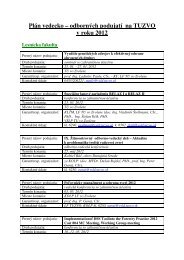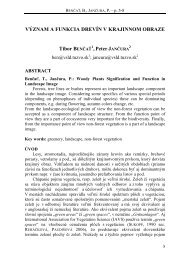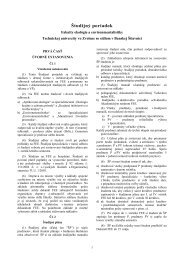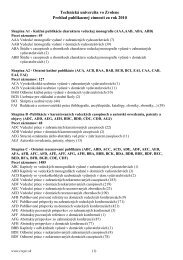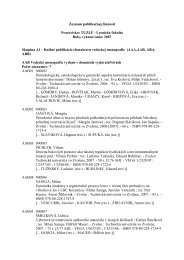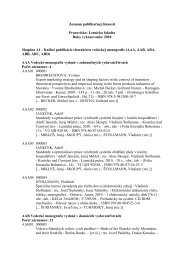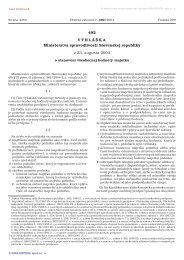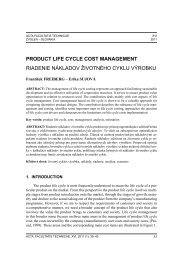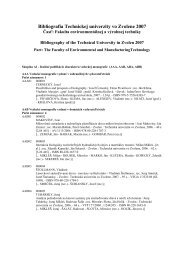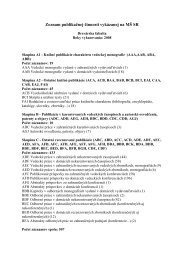Acta Facultatis Ecologiae - Technická univerzita vo Zvolene
Acta Facultatis Ecologiae - Technická univerzita vo Zvolene
Acta Facultatis Ecologiae - Technická univerzita vo Zvolene
- No tags were found...
Create successful ePaper yourself
Turn your PDF publications into a flip-book with our unique Google optimized e-Paper software.
39222Rn is produced by radioactive decay of 226 Rain the soil grains. Part of the produced 222 Rn getsinto the soil air. Then it is transported mostly bydiffusion processes into the atmosphere. Decayproducts of 222 Rn remain in the soil because theyare solid state metals. The amount of 222 Rn thatescapes from the soil to the atmosphere depends onthe depth where radon was created and on the permeabilityof the surrounding soil. Radon present inthe atmosphere is created mostly in the top 10 m ofthe soil [6].Exhalation rate of 222 Rn generally dependson 226 Ra content in soil, diffusion and emanationcoefficient and soil properties. Average exhalationrate has been estimated to be 0.7–1.3 atoms.cm –2 s –1 . 222 Rn exhalation from oceans is 2–3 ordersof magnitude lower than from the ground surface[6]. Significant variations in 222 Rn exhalation ratehave not been proved yet.222Rn gets to the atmosphere also by emanationfrom ground water. The mechanism is simple. Afterthe ground water enters the atmospheric environment,the majority of radon is released. Other222Rn sources, mostly of anthropogenic origin, arenegligible when compared to the previously mentionedones [7].METHODSContinual measurements of 222 Rn activity concentrationin the outdoor atmosphere has been carriedout since 1991 at the Faculty of Mathematics,Physics and Informatics. Samples are collectedabove an open grassy area in front of the facultybuilding at a height of 1.5 m above the earth’s surface.A high-<strong>vo</strong>lume scintillation chamber has beenused for the measurement of 222 Rn activity concentration.The detector itself is a cylinder made ofbrass, with a diameter of 12 cm and with a length of40 cm. The chamber <strong>vo</strong>lume is approximately 4.5l. ZnS(Ag) has been chosen as a scintillation material.At each side of the detector there is a glassywindow and a photomultiplier tube. The drawn-inair enters the peripheral sectors first and then, passingnear the windows, it goes to the inner sectorand finally it is drained out. The air flow throughthe detector is 0.5 l/min.Before the air enters the detector itself, firstlyit passes through a high-<strong>vo</strong>lume tube where 220 Rn(T 1/2= 55 s) decays completely. In the next stepthere is a system of freezing traps and silica gelboxes where the H 2O vapour is removed from thesucked air at a temperature of –20 °C. Just beforethe detector there is a membrane filter used forcollecting aerosols with deposited 222 Rn decay products.Using this experimental setup it is ensuredthat only pure air and 222 Rn enters the scintillationchamber [8].RESULTS AND DISCUSSIONBecause of the huge datasets that have to beprocessed, the direct EMH numerical computationsare out of question. For example to solve equation(3) numerically for a single year takes approximately4300 calculations. The only effective solution isthe use of PC along with an appropriately programmedcode. From several programming languagessuitable for our purposes we chose the MATHE-MATICA 5 package. The results of the numericalcomputation could be presented in a form of tablesor by synoptic charts. To be as clear as possible, wehave chosen the second way.Equivalent mixing height was computed in thetime interval from 1.1.2004 to 31.12.2004. Becauseof the limited space available we cannot presentthe full results here. In order to be brief we presentjust illustrative example results for summer as wellas winter season. As one can see in figure 3, the coursesof 222 Rn activity concentration and EMH anticorrelatesnearly ideally (when the 222 Rn <strong>vo</strong>lumeactivity is high, EMH gets low and vice versa).Statistical summary of numerical results offersinteresting conclusions. Firstly, daily variations ofEMH are observed. It is clear that the EMH reachesa maximum in the afternoon between 2–4 p.m. anda minimum just before sunrise. This pattern is especiallywell visible in the summer season when theamplitude of the temperature is high enough to boostthe eddy diffusion and convective turbulence.To obtain an evidence of the presence of annualEMH variations we carried out the harmonic Fourieranalysis of the averaged diurnal EMH waves.The tested Fourier series were restricted to the firsttwo harmonic terms:⎛ p ⎞ ⎛ p ⎞f ( x) = A + Bsin ⎜ t + pj⎟ + C sin ⎜ t + py⎝⎟ .12 ⎠ ⎝ 6 ⎠(10)Function (10) is used for characterization of thetime courses of 222 Rn activity concentration and for



